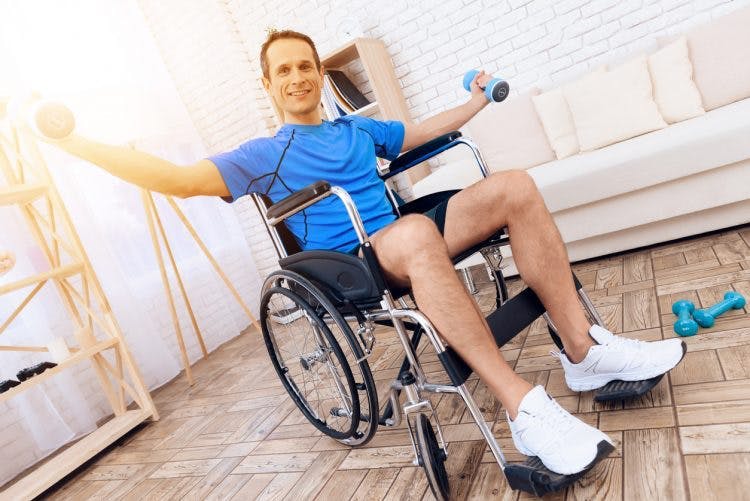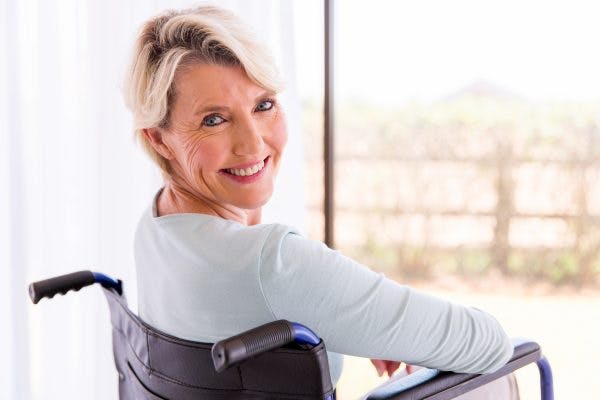If your spinal cord injury results in quadriplegia (weakness or paralysis throughout the arms, trunk, and legs), it can feel challenging to participate in exercises. However, there are many different forms of exercises available to help you optimize your daily function and promote recovery after spinal cord injury.
Exercise after spinal cord injury is essential because it helps promote circulation and maintain range of motion, bone density, and muscle mass. Movement is also necessary to avoid additional complications after spinal cord injury and to maximize your ability to participate in daily activities.
In this article we will discuss the importance of exercise after quadriplegia as well as examples of exercises for passive range of motion, upper body strength, and mobility. You can use these links to help you navigate through this article:
- The importance of exercise after quadriplegia
- Breathing exercises
- How to prepare for passive exercises
- Passive range of motion exercises
- Upper body exercises
- How to improve mobility
The Importance of Exercise After Quadriplegia
As we know, exercise is a vital component of overall health, both physical and mental. This is just as true for individuals following spinal cord injury, even if that injury results in quadriplegia. Since active motion becomes limited with quadriplegia, it is necessary to find alternative ways to incorporate movement into your daily life.
Regular exercise can benefit individuals with quadriplegia in a variety of ways. For example, exercise has been shown to have a positive impact on respiration (breathing) and circulation following spinal cord injury. Movement can help prevent secondary complications such as pressure sores, leg swelling, or edema and prevent infections like pneumonia. Regular exercise can also improve digestive function and reduce risk of constipation or urinary tract infections.
Furthermore, regular exercise can have a positive impact on mental health and self-esteem for individuals with quadriplegia. In one study, for example, researchers found that increased participation in daily activity was associated with lower incidence of anxiety and depression for individuals affected by spinal cord injury. This highlights the importance of exercise after quadriplegia and will hopefully encourage you to stay motivated to pursue rehabilitation.
Breathing Exercises After Quadriplegia
Breathing function and overall respiratory health are incredibly important following a spinal cord injury, especially for individuals with quadriplegia. Depending on the level of injury, the muscles of the diaphragm and abdomen are often affected. This means it is vital to perform daily breathing exercises to help maximize respiratory function. Here are some breathing exercises to get you started:
- Deep Breathing: Take a deep breath in through the nose, working to expand the lungs and chest. Hold this breath for 2-3 seconds, then release slowly through pursed lips.
- Air Stacking: Start by sitting upright or recline slightly with support behind your back. Take a deep breath in and hold, then breathe in more air and hold. Continue this 4-5 times without exhaling and hold 2-3 seconds, then exhale slowly to finish one cycle of the exercise.
- Number Counting: Take a deep breath in, then release the breath slowly while counting out loud. Try to gradually increase the number you can reach to improve your breath control.
Additionally, another great breathing practice is the Active Cycle of Breathing Technique (ACBT). Talk with your rehab team to create a breathing program that is optimal for your specific needs. Your physical therapist can also assist you with stretches for your trunk to improve chest expansion and make breathing easier.
How to Prepare for Passive Range of Motion Exercises for Quadriplegia
All individuals with quadriplegia can practice passive range of motion exercises. This type of exercise requires no active muscle contraction or intense physical exertion. Instead, a physical therapist, occupational therapist, or trained caregiver will facilitate your movements for you to make sure your joints move through their full range of motion.
The benefits of passive range of motion exercises include improved blood flow, flexibility, and reduced pain after spinal cord injury. Furthermore, passive range of motion exercises provide a perfect opportunity for your therapist or caregiver to check for any skin integrity issues that may develop, helping to prevent pressure sores.
Please note that these exercises may not be appropriate if you have been given specific precautions due to your SCI or other injuries you may have sustained. For example, some individuals will have a neck or back brace and “spinal precautions” after their injury, which are specific ways they should NOT be moving their spine.
These types of precautions are typically necessary for around 12 weeks after injury, but your doctor will be the one to remove these precautions when it is safe and appropriate. Be mindful of these precautions when looking through these exercises.
These specific exercises are designed for someone else to be performing the movement for you. However, as you continue practicing these passive range of motion exercises, you may find that you are able to actively help with some of the movements. This is a great sign of recovery! Even if you are unable to move independently, however, these exercises are still beneficial for your joints, muscles, and circulation.
Getting Started with Passive Range of Motion Quadriplegia Exercises
Generally, each of these exercises for quadriplegia should be completed on both sides of the body, ideally every day or at least multiple times per week. A slow stretching motion with a 5-10 second hold at the end range of motion is typically the most effective. Some passive range of motion exercises you and your caregiver can practice at home include:
- Finger Flexion and Extension: Curl the fingers inward towards the palm, creating a fist, and extend them back so that they are straight. Keep the wrists neutral (straight) while doing this.
- Finger O’s: Touch the tip of each finger to the tip of the thumb.
- Finger Abduction (Splits): Separate any two adjacent fingers by moving them away from each other, then bring them back together.
- Wrist Flexion and Extension: Bend the wrist so that the palm moves towards the inner arm and makes a 90° angle. Then, extend the wrist in the opposite direction. If the individual has some hand movement preserved and is working on use of a “tenodesis grasp” in therapy, then be sure to keep their fingers curled in rather than fully extended while performing this wrist exercise.
- Forearm Rotation: Start with the elbows bent at 90° at the individual’s sides with the back of the hands facing up. With one hand, hold just above the elbow and with the other, flip the hand over so that the palm faces up. Forearm rotation can also be completed with the arms straight and positioned at the individual’s sides.
- Elbow Flexion and Extension: Bend the elbow so that the hand can touch the shoulder. Then extend it so that the arm is fully straight.
- Shoulder Flexion: Start with the arm relaxed at the individual’s side so that the palm is facing inward. Keeping the elbow straight, raise the arm forward slowly, gradually bringing it up so that the hand is reaching up and the arm is as close to the ear as possible.
- Shoulder Abduction (Snow Angels): Start with the arm straight with the palm facing forward. Slowly bring the hand and arm outward to the side, away from the center of the body. The arm should be level with the shoulders or higher. Then, bring the arm back to the starting position. When done consecutively, it will look like you are making a snow angel.
- Ankle Rotations: Put one hand just above the ankle to stabilize the leg and the other hand on the foot. Then move the foot in circular motions as well as “gas pedal” motions to stretch the ankle and calf.
- Toe Flexion and Extension: Bend the toes in towards the sole of the foot and bring them back out to neutral. Then extend them upward toward the shin to stretch the bottom of the foot.
The following hip and knee passive range of motion exercises should be performed lying down.
- Lower Trunk Rotation: For this exercise, the individual should be lying down on his or her back with knees together and bent. Tilt the knees gently towards one side and then the other. Make sure the shoulders stay in place and don’t move. If you wear a back brace or neck brace of any kind or have been told you have “spinal precautions,” do NOT perform this exercise and talk to your therapist and/or doctor about when you can try it.
- Hip Rotation: Bend one knee so that the thigh is perpendicular to the mat/bed and there’s a 90° angle at the knee. Start to rotate the hip in the socket by holding the thigh just above the knee and moving the foot inward toward the opposite leg. Then reverse the direction of rotation and move the foot outward, keeping the thigh perpendicular to the mat the whole time.
- Hip Abduction: The legs should be straight. Pull one leg to the side (away from the midline of the body), creating separation between the feet until there’s slight muscle resistance. Then, bring the feet back together. It should look like you are performing the leg portion of a snow angel.
- Knees to Chest: With one hand on the upper leg just above the knee and the other hand holding the foot, bend one hip so that the knee is reaching towards the chest. Then, bring the foot back down and straighten the knee before performing this motion on the other side.
For a demonstration of how passive range of motion exercises are performed, watch the video below.
As you progress, you may be able to increase your participation in these exercises. This will allow you to become more comfortable performing range of motion exercises on your own, requiring less assistance from a therapist or caregiver. Although quadriplegia affects all four limbs, individuals with an incomplete or lower level of injury may be able to perform some passive range of motion exercises independently.
Upper Body Quadriplegia Exercises
Individuals with quadriplegia and their rehabilitation teams will often focus on improving upper-body mobility. By doing so, individuals can significantly increase their independence with activities of daily living and use their arms and hands to assist with mobility of the lower body. That being said, it’s important to practice exercises for your lower body (such as passive range of motion) as well, to whatever degree possible.
Here we will discuss additional exercises that focus on developing upper body strength and mobility for individuals with quadriplegia. Keep in mind that muscle function after SCI depends on the level of injury, so you may need to modify or scale these exercises to fit your abilities.
Talk with your therapy team to help create an optimal exercise plan for you. Additionally, you can take a look at this strengthening program to give you some ideas or follow along with the following exercises we have provided for you:
- Neck Tilts: Tilt your neck so that your left ear moves towards your left shoulder and then do the same for your right side, keeping the shoulders relaxed. Important note: If you wear a neck brace of any kind or have been told you have “cervical spinal precautions,” do NOT perform this exercise and talk to your therapist and/or doctor about when you can try it.
- Neck Rotation: Turn the head from side to side slowly as if looking over your shoulder or signaling ‘no’; the eyes should stay level the entire time.
- Shoulder Shrug: Shrug your shoulders up towards your ears and then bring them back down.
- Shoulder Rolls: With your arms relaxed at your sides, roll your shoulders forward and backward in slow circles.
- Shoulder Blade Rows: With your arms in front of you or at your sides, squeeze your shoulders together like you are pinching a pencil between your shoulder blades.
- Shoulder Flexion: Start with your arms at your sides so that the palm is facing inward. Keeping the arm straight, raise the arm forward slowly, gradually reaching upward and aiming to have the arm as close to the ear as possible. If you have cervical spinal precautions, do not raise your arms any higher than shoulder-height.
- Shoulder Abduction (Snow Angels): Start with the arms straight at your sides with palms facing forward. Slowly bring the arms out to the side, away from the center of the body and toward your ears. Then, bring the arms back to the starting position. When done consecutively, it will look like you are making a snow angel.
- Arm Circles: Raise your arms to the side so that your body makes a “T” shape and move them in little circles forward and backward.
- Crossbody Reach: Take one arm and reach across the opposite side of the body, working to control your trunk at the same time. Then return to neutral and repeat on the opposite side.
- Chest Press: Lying down, bend your elbows to 90° and “punch” your arms forward toward the ceiling, thinking about bringing your armpits toward each other. Then lower slowly; the more slowly you lower your arms, the more challenging the exercise will be.
- Forearm Rotation: Put your arm out straight in front of you with your palm facing down and then flip it so that your palm faces up. This can also be completed with your elbow bent at your side.
- Gripping: Make a fist and squeeze all your fingers together. Then, open your hand and stretch out your fingers as much as you can. You can add therapy putty or a stress ball in your hand for some resistance.
- Sitting Balance: With someone nearby, try sitting up as straight as possible on the side of the bed or in a chair/wheelchair. As you are able, slowly decrease support from your arms to challenge your balance and the strength of your posture muscles. Again, this should be performed with someone nearby to “spot” you.
These exercises focus on building strength and stamina for individuals with quadriplegia. Again, every injury is different depending on the level and severity, so understand that it is okay to modify exercises based on your specific needs. To help inspire you, here is another upper body exercise program created by an individual with quadriplegia:
Improve Mobility with Quadriplegia Through Exercises
There are many negative secondary effects that occur following spinal cord injury that can lead to additional complications. As we discussed before, these complications can include blood clotting, pressure sores, and bone thinning, which can all be made worse by a sedentary lifestyle. Therefore, it’s essential for individuals with quadriplegia after spinal cord injury to move frequently in order to prevent these complications.
Even you have minimal voluntary movement, it is vital to seek help and ask a caregiver to passively move your body for you. However, this does not mean you should be idle during passive exercises. Instead, focus on those passive movements and be alert for any changes in sensation or motor control. It is important to participate as much as you can to maximize your recovery.
Individuals with incomplete quadriplegia have the potential to improve function below their level of injury because the spinal cord can utilize neuroplasticity to heal. Neuroplasticity refers to the central nervous system’s ability to rewire itself and strengthen functions weakened by injury. Consistently repeating exercises and movement patterns helps stimulate neuroadaptive changes in the spinal cord and strengthen new connections. The more you practice, the more efficient your movements will become.
By participating in intensive rehabilitative therapies and practicing high repetitions of targeted exercises, individuals with incomplete quadriplegia may be able to promote neuroplasticity and recover movement. Additionally, all individuals should practice the exercises they learn at physical or occupational therapy at home. To stay motivated, gamified neurorehabilitation devices like FitMi home therapy can help make rehab engaging to encourage consistency.
Exercises for Quadriplegia: Key Points
It can be challenging for individuals with quadriplegia to participate in exercises since all four limbs are affected. However, an active lifestyle is incredibly important to help prevent complications and promote independence.
Following a spinal cord injury, there are many ways to incorporate exercises into your daily routine. This can include breathing exercises to improve respiration as well as passive range of motion to maximize mobility. Additionally, individuals with quadriplegia can participate in strengthening exercises and even some cardio to help improve overall health and performance of daily tasks.
Exercise does not necessarily have to be strenuous to be effective, and frequent, purposeful movement can make a huge difference in recovery. We hope this article helped you understand what individuals with quadriplegia can do to incorporate more physical activity into their daily routines and the benefits these exercises provide.











